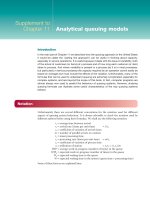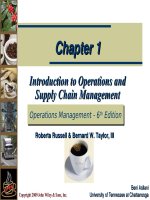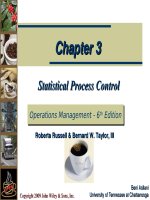Operation management 6e by russel and taylor ch12
Bạn đang xem bản rút gọn của tài liệu. Xem và tải ngay bản đầy đủ của tài liệu tại đây (2.17 MB, 67 trang )
Chapter 12
Forecasting
Operations
Operations Management
Management -- 66thth Edition
Edition
Roberta Russell & Bernard W. Taylor, III
Copyright 2009 John Wiley & Sons, Inc.
Beni Asllani
University of Tennessee at Chattanooga
Lecture Outline
Strategic Role of Forecasting in Supply
Chain Management
Components of Forecasting Demand
Time Series Methods
Forecast Accuracy
Time Series Forecasting Using Excel
Regression Methods
Copyright 2009 John Wiley & Sons, Inc.
12-2
Forecasting
Predicting the future
Qualitative forecast methods
subjective
Quantitative forecast
methods
based on mathematical
formulas
Copyright 2009 John Wiley & Sons, Inc.
12-3
Forecasting and Supply Chain
Management
Accurate forecasting determines how much
inventory a company must keep at various points
along its supply chain
Continuous replenishment
supplier and customer share continuously updated data
typically managed by the supplier
reduces inventory for the company
speeds customer delivery
Variations of continuous replenishment
quick response
JIT (just-in-time)
VMI (vendor-managed inventory)
stockless inventory
Copyright 2009 John Wiley & Sons, Inc.
12-4
Forecasting
Quality Management
Accurately forecasting customer demand is
a key to providing good quality service
Strategic Planning
Successful strategic planning requires
accurate forecasts of future products and
markets
Copyright 2009 John Wiley & Sons, Inc.
12-5
Types of Forecasting Methods
Depend on
time frame
demand behavior
causes of behavior
Copyright 2009 John Wiley & Sons, Inc.
12-6
Time Frame
Indicates how far into the future is
forecast
Short- to mid-range forecast
typically encompasses the immediate future
daily up to two years
Long-range forecast
usually encompasses a period of time longer
than two years
Copyright 2009 John Wiley & Sons, Inc.
12-7
Demand Behavior
Trend
a gradual, long-term up or down movement of
demand
Random variations
movements in demand that do not follow a pattern
Cycle
an up-and-down repetitive movement in demand
Seasonal pattern
an up-and-down repetitive movement in demand
occurring periodically
Copyright 2009 John Wiley & Sons, Inc.
12-8
Demand
Demand
Forms of Forecast Movement
Random
movement
Time
(b) Cycle
Demand
Demand
Time
(a) Trend
Time
(c) Seasonal pattern
Copyright 2009 John Wiley & Sons, Inc.
Time
(d) Trend with seasonal pattern
12-9
Forecasting Methods
Time series
statistical techniques that use historical demand data
to predict future demand
Regression methods
attempt to develop a mathematical relationship
between demand and factors that cause its behavior
Qualitative
use management judgment, expertise, and opinion to
predict future demand
Copyright 2009 John Wiley & Sons, Inc.
12-10
Qualitative Methods
Management, marketing, purchasing,
and engineering are sources for internal
qualitative forecasts
Delphi method
involves soliciting forecasts about
technological advances from experts
Copyright 2009 John Wiley & Sons, Inc.
12-11
Forecasting Process
1. Identify the
purpose of forecast
2. Collect historical
data
3. Plot data and identify
patterns
6. Check forecast
accuracy with one or
more measures
5. Develop/compute
forecast for period of
historical data
4. Select a forecast
model that seems
appropriate for data
7.
Is accuracy of
forecast
acceptable?
No
8b. Select new
forecast model or
adjust parameters of
existing model
Yes
8a. Forecast over
planning horizon
9. Adjust forecast based
on additional qualitative
information and insight
Copyright 2009 John Wiley & Sons, Inc.
10. Monitor results
and measure forecast
accuracy
12-12
Time Series
Assume that what has occurred in the past will
continue to occur in the future
Relate the forecast to only one factor - time
Include
moving average
exponential smoothing
linear trend line
Copyright 2009 John Wiley & Sons, Inc.
12-13
Moving Average
Naive forecast
demand in current period is used as next period’s
forecast
Simple moving average
uses average demand for a fixed sequence of
periods
stable demand with no pronounced behavioral
patterns
Weighted moving average
weights are assigned to most recent data
Copyright 2009 John Wiley & Sons, Inc.
12-14
Moving Average:
Naïve Approach
MONTH
Jan
Feb
Mar
Apr
May
June
July
Aug
Sept
Oct
Nov
ORDERS
FORECAST
PER MONTH
120
90
120
100
90
75
100
110
75
50
110
75
50
130
75
110
130
90
110
90
Copyright 2009 John Wiley & Sons, Inc.
12-15
Simple Moving Average
n
Σ
i = 1 Di
MAn =
n
where
n
Di
= number of periods
in the moving
average
= demand in period i
Copyright 2009 John Wiley & Sons, Inc.
12-16
3-month Simple Moving Average
MOVING
AVERAGE
ORDERS
MONTH
PER
Jan
–
MONTH
120
–
Feb
–
90
103.3
Mar
88.3
100
95.0
Apr
78.3
75
78.3
May
85.0
110
105.0
June
110.0
50
July
Copyright 2009 John Wiley & Sons, Inc.
3
Σ
i=1
MA3 =
=
Di
3
90 + 110 + 130
3
= 110 orders
for Nov
12-17
5-month Simple Moving Average
MOVING
AVERAGE
ORDERS
MONTH
PER
Jan
–
MONTH
120
–
Feb
–
90
–
Mar
–
100
99.0
Apr
85.0
75
82.0
May
88.0
110
95.0
June
91.0
50
July
Copyright 2009 John Wiley & Sons, Inc.
5
Σ
i=1
MA5 =
=
Di
5
90 + 110 + 130+75+50
5
= 91 orders
for Nov
12-18
Smoothing Effects
150 –
125 –
5-month
Orders
100 –
75 –
50 –
3-month
25 –
Actual
0–
|
Jan
|
Feb
|
Mar
|
Apr
|
|
|
May June July
Month
Copyright 2009 John Wiley & Sons, Inc.
|
|
Aug Sept
12-19
|
Oct
|
Nov
Weighted Moving Average
n
Adjusts
moving
average
method to
more closely
reflect data
fluctuations
WMAn = Σ Wi Di
i=1
i=1
where
Wi = the weight for period i,
between 0 and 100
percent
Σ W = 1.00
i
Copyright 2009 John Wiley & Sons, Inc.
12-20
Weighted Moving Average Example
MONTH
WEIGHT
DATA
August
September
October
17%
33%
50%
130
110
90
November Forecast
3
WMA3 = iΣ
= 1 Wi Di
= (0.50)(90) + (0.33)(110) + (0.17)(130)
= 103.4 orders
Copyright 2009 John Wiley & Sons, Inc.
12-21
Exponential Smoothing
Averaging method
Weights most recent data more strongly
Reacts more to recent changes
Widely used, accurate method
Copyright 2009 John Wiley & Sons, Inc.
12-22
Exponential Smoothing (cont.)
Ft +1 = α Dt + (1 - α)Ft
where:
Ft +1 = forecast for next period
Dt =
actual demand for present period
Ft = previously determined forecast
for present period
α = weighting factor, smoothing constant
Copyright 2009 John Wiley & Sons, Inc.
12-23
Effect of Smoothing Constant
0.0 ≤ α ≤ 1.0
If α = 0.20, then Ft +1 = 0.20 Dt + 0.80 Ft
If α = 0, then Ft +1 = 0 Dt + 1 Ft = Ft
Forecast does not reflect recent data
If α = 1, then Ft +1 = 1 Dt + 0 Ft = Dt
Forecast based only on most recent data
Copyright 2009 John Wiley & Sons, Inc.
12-24
Exponential Smoothing (α=0.30)
PERIOD
DEMAND
MONTH
F2 = α D1 + (1 - α )F1
= (0.30)(37) + (0.70)(37)
1
Jan
37
= 37
2
Feb
40
F3 = α D2 + (1 - α )F2
3
Mar
41
4
Apr
37
5
May
45
= (0.30)(40) + (0.70)(37)
= 37.9
F13 = α D12 + (1 - α )F12
= (0.30)(54) + (0.70)(50.84)
= 51.79
6
Jun
50
7
JulJohn Wiley43
Copyright
2009
& Sons, Inc.
12-25









